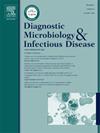A novel flow through assay and smartphone application based prototype for point-of-care diagnosis of tuberculosis
IF 2.1
4区 医学
Q3 INFECTIOUS DISEASES
Diagnostic microbiology and infectious disease
Pub Date : 2025-02-20
DOI:10.1016/j.diagmicrobio.2025.116766
引用次数: 0
Abstract
Affordable point-of-care test sensors with automated result recording are essential for reducing undetected tuberculosis cases in remote, resource-limited areas. Therefore, this study addresses this need with three key aims. First, we aimed to lower the costs of a patented flow-through assay (Kit and method: WO2016/024116A1) by developing an in-house method for producing antibody-coated gold nanoparticles (anti-IgG-AuNPs). These anti-IgG-AuNPs demonstrated specific binding with performance comparable to existing antibody-capped gold nanoparticles. The second aim was to transform the flow-through assay into a multi-disease screening tool by incorporating multiple antigen test spots. A newly designed wax-printed background allows for simultaneous testing of up to five antigens, delivering results within 15 min at the point-of-care, while also reducing assay costs by 70 %. Lastly, we developed a smartphone application (RAP-TBS) to provide quantitative analysis of the flow-through assay results. This user-friendly app requires no additional hardware and addresses the limitations of subjective visual interpretation.
求助全文
约1分钟内获得全文
求助全文
来源期刊
CiteScore
5.30
自引率
3.40%
发文量
149
审稿时长
56 days
期刊介绍:
Diagnostic Microbiology and Infectious Disease keeps you informed of the latest developments in clinical microbiology and the diagnosis and treatment of infectious diseases. Packed with rigorously peer-reviewed articles and studies in bacteriology, immunology, immunoserology, infectious diseases, mycology, parasitology, and virology, the journal examines new procedures, unusual cases, controversial issues, and important new literature. Diagnostic Microbiology and Infectious Disease distinguished independent editorial board, consisting of experts from many medical specialties, ensures you extensive and authoritative coverage.

 求助内容:
求助内容: 应助结果提醒方式:
应助结果提醒方式:


